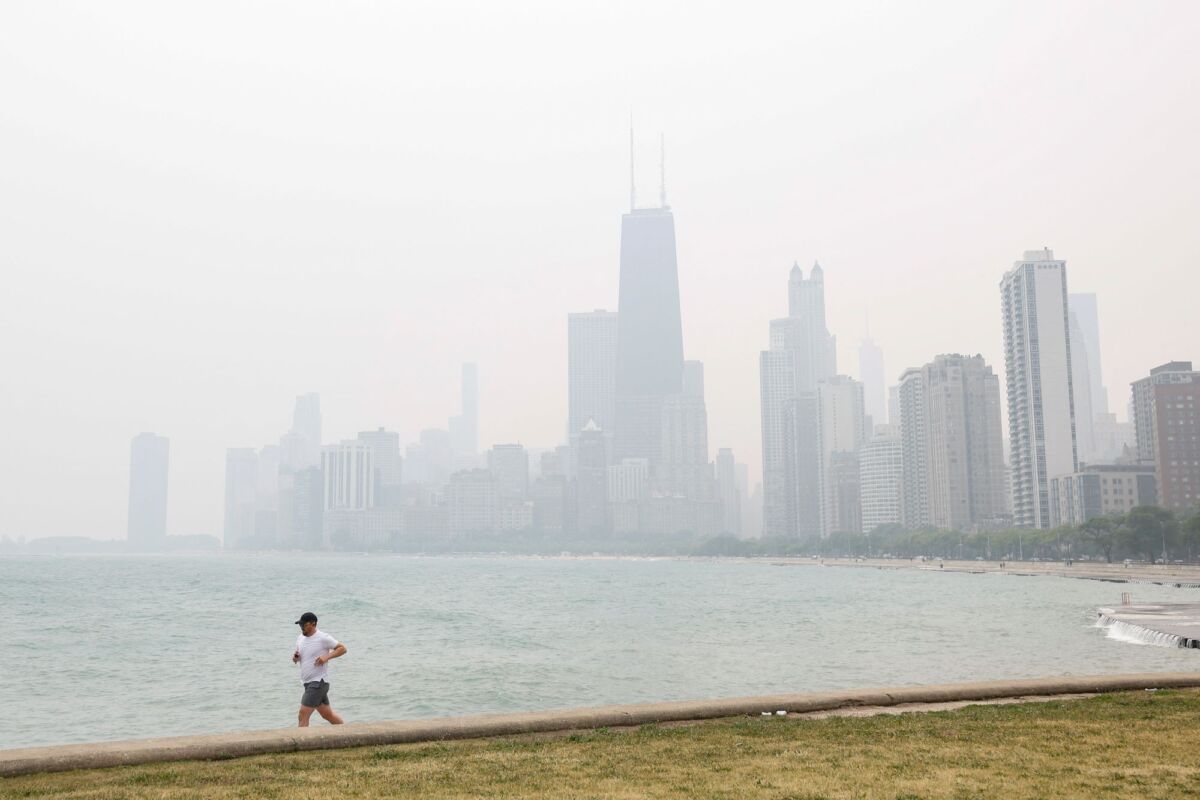Smoke from Canadian wildfires is blanketing cities in the United States, with air quality warnings in effect across the Midwest and toward the East Coast as hundreds of fires rage out of control north of the border.
The Detroit area woke up on Wednesday to some of the worst air quality in the United States as smoke from Canada’s 480 wildfires blanketed much of the Great Lakes region.
Earlier in the day, the Environmental Protection Agency’s AirNow site showed Detroit in the “hazardous” range and warned that “everyone should stay indoors and reduce activity levels.” The alert has since been downgraded to “very unhealthy,” with older adults, children and teens, as well as people with lung disease, advised to stay indoors.
The dark haze spread as far south as Missouri and Kentucky, with around 87 million people at risk of poor air quality due to the smoke, according to the tracking service IQAir.com.
Three U.S. cities—Chicago, Detroit, and Minneapolis—were in the top five in terms of the worst air quality globally, per the tracker.

The National Weather Service said that air quality alerts had been issued for the entire states of Iowa, Wisconsin, Illinois, Indiana, Michigan, Delaware, and Maryland.
At the same time, parts of Kansas, Missouri, Minnesota, Ohio, Pennsylvania, New York, Virginia, and North Carolina had been put on alert due to poor air quality.
“Another round is going through western New York, western Pennsylvania later today,” National Weather Service meteorologist Byran Jackson said Wednesday. “And then that continues over the northern Mid-Atlantic. It will persist there into Thursday.”
“There’s particularly poor air quality … over southern Wisconsin, Illinois, central Indiana, and also another area over southeast Michigan, Detroit and northeast Ohio around Cleveland,” Jackson added. “This is particularly thick smoke.”

Minnesota issued a record twenty-third air quality alert for the year through late Wednesday night, as smoky skies obscured the skylines of Minneapolis and St. Paul.
Chicago Mayor Brandon Johnson urged young people, older adults and residents with health issues to spend more time indoors while unsafe conditions continue and pledged “swift action to ensure that vulnerable individuals have the resources they need to protect themselves and their families.”
Record-Breaking Burn
Across Canada, 480 fires are burning, with 239 of them considered to be out of control, according to the Canadian Interagency Forest Fire Centre (CIFFC).
The wildfire intensity is so high this season that it took just six months to break a record that was set an entire year decades ago.
The CIFFC said Monday that 29,393 square miles of land, including forests, has burned across Canada so far this year, breaking the previous record set in 1989 of 29,187 square miles.
Canada’s federal Emergency Preparedness Minister Bill Blair said last week he wasn’t “looking to break any records” but acknowledged it was probably inevitable.
“Unfortunately, the fire season this year started earlier and has been more widespread across the country than in recent memory,” he said, according to Canadian news outlet Globe and Mail.
Air quality statements were issued by Environment Canada on Wednesday for large swaths of Ontario and Quebec, warning residents about elevated levels of air pollution caused by the smoke.
Plumes of smoke from the wildfires have cast a dark pall over affected areas, including the Greater Toronto Area, Hamilton, Windsor, Barrie, and London in Ontario, as well as the majority of northern Quebec.
Earlier this month, massive fires burning stretches of Canadian forests blanketed the northeastern United States and the Great Lakes region with smoke, turning the air yellowish gray and prompting warnings for people to stay inside and keep windows closed.
The small particles in wildfire smoke can irritate the eyes, nose and throat and can affect the heart and lungs, making it harder to breathe. Health officials say it’s important to limit outdoor activities as much as possible to avoid breathing in the particles.
President Joe Biden has said that hundreds of American personnel have joined Canadians to fight the fires.
CBO Releases Wildfire Impact Analysis
The non-partisan Congressional Budget Office (CBO) recently issued an analysis of wildfire activity in the United States, highlighting concerning trends and far-reaching impacts on the environment, public health, and the economy.
The findings shed light on the increasing scale of wildfires, the substantial financial costs involved, and the urgent need for effective forest management strategies.
Between the years 2017 and 2021, an average of 8 million acres each year succumbed to wildfires. This figure represents more than double the average amount recorded between 1987 and 1991, signaling an escalation in the frequency and severity of these disasters. Fires on federal lands were found to be five times larger, on average, than those on nonfederal lands.
The financial toll of fire suppression has been significant, the CBO analysis shows. Over the course of the past five years (2016-2020), the average annual spending by the federal government on fire suppression alone amounted to $2.5 billion. This figure does not include other federal fire-related expenses, such as disaster assistance, which totaled $5 billion for declared disasters during the same period.
Indirect costs, such as healthcare expenses resulting from smoke exposure and potential revenue losses from federal timber sales, add to the economic burden of wildfires.
The impact of wildfires extends more broadly than just in the immediate vicinity of the fires, the CBO analysis showed. Smoke and air pollution originating from wildfires have the potential to spread widely, worsening various health conditions. Furthermore, wildfires have a negative impact on watersheds, further straining ecosystems and natural resources.
The CBO analysis recommends proactive forest management to help mitigate the risk and severity of wildfires, including implementing prescribed fires, managing wildfires in remote areas, and mechanically thinning forests to reduce vegetation density and fuel load.
However, the costs associated with implementing these approaches vary depending on the landscape and the specific treatment required.
The Associated Press contributed to this report.
From The Epoch Times

